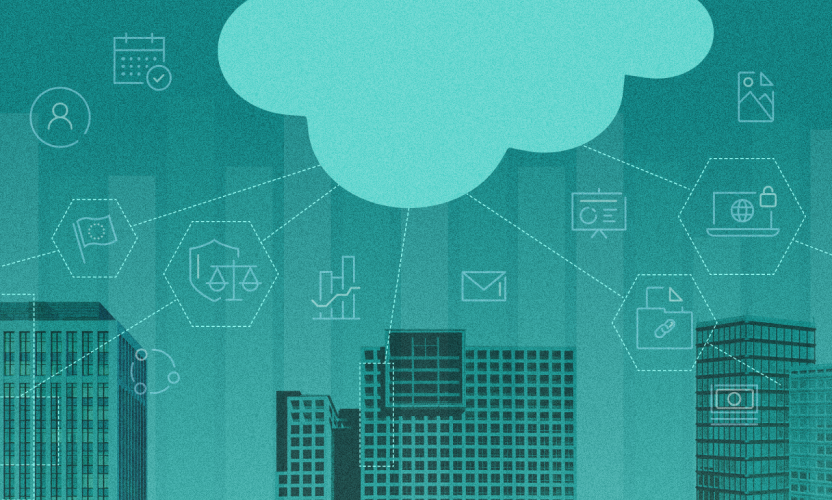
5 Risk Mitigation Strategies That Can Save Your Business Lots of Money
Businesses sit on massive, ever-growing piles of data. According to Dave Reinsel, senior vice president, IDC's Global DataSphere, 64.2 zettabytes of data was created or replicated in 2020. And the amount of digital data created over the next five years will be greater than twice the amount of data created since the advent of digital storage.
But data isn’t just growing, it is spreading to more applications, more users, and more devices than ever. More so, this content sprawl is creating inefficiencies, driving up costs and contributing to new and greater data security risks. It’s no wonder that IT leaders' biggest concern is the increased risk of a data breach or leak.
Cyberattacks cost small businesses $200,000 and larger businesses $3.86 million a year on average. Data breaches and non-compliance are likewise expensive. In 2019, Equifax paid $1.14 billion for data breaches.
Having your data at risk can cost your business more than you think in terms of money, security, and reputation.
The good news is that there are actionable ways to mitigate risk and protect your company’s good name. Take the human error out of data management and follow these strategies to help prevent reputation damage, preserve revenue, and ultimately make your business a more trustworthy service provider.
Strategy 1: Automate Data Monitoring
Monitoring the quality of your data is critical to managing security. Anyone can potentially identify weaknesses within your data, but automated data monitoring is a much more effective way to mitigate risk.
It removes the manual work by identifying risk within your data, saving you time and labor to facilitate security and compliance. It’s also more accurate than manual monitoring, which can be prone to human error.
Identify Vulnerabilities to Cyberattacks
Automated data monitoring can help identify vulnerabilities that make organizations like yours susceptible to attack. And those attacks mean companies are also susceptible to being faced with enormous expenses.
In a classic example from 2008, Heartland Payment Systems unintentionally exposed 134 million credit cards when it experienced a SQL Injection attack.
The attackers took advantage of a known vulnerability in Heartland’s system—and Heartland was met with serious repercussions as a result. First, Heartland was limited from processing payments from major credit card providers until May 2009. Then, it had to pay an estimated $145 million to compensate users for fraudulent payments.
It also potentially lost millions of dollars in revenue due to damage to its reputation. That lack of trust can have long-term implications for the overall perception of your business in terms of new customer acquisition and overall trust.
Identify Critical Data Buried Within Dark Data
Automated monitoring also helps organizations identify critical data and potential areas of risk buried within so-called “dark data”—unstructured data housed within your organization. Believe it or not, it may comprise the majority of your data. In fact, one study estimates that on average, 68% of data goes unleveraged.
In other words, 68% of your company’s data may constitute dark data.
Automated monitoring can quickly sift through dark data to help identify potential vulnerabilities and alert you to take action. Doing so not only mitigates risk; it also helps you get a better handle on the overall state of your company’s data, which you can use to cut down on content sprawl.
Mitigate Ransomware Attacks
Ransomware is a type of malware—one that specifically takes control of data until a ransom is paid. While ransomware threats have been around for more than 30 years, they have grown increasingly advanced and malicious in the past few years.
So much so that there were 304 million ransomware attacks in 2020.
Automated monitoring includes automated ransomware detection that helps identify potential ransomware and reduces the impact of attacks.
Strategy 2: Document Core Safety and Security Policies
User error is one of the most often overlooked risks to your data security. Unstandardized employee offboarding, passwords saved insecurely, and sensitive information sent over email are all common security risks that result from user error—which, in turn, can cause careless breaches and compliance issues.
Documenting safety and security policies, however, can help prevent employees from making unintentional errors. And it gives you a clear and well-defined process for managing access to your company’s secure information.
Reduce Risk from Employee Offboarding.
Depending on their tenure and responsibility, a single employee can exchange, store, and interact with an enormous amount of data in your organization.
That means each employee can also represent a significant risk when they leave. With access to critical data, valuable passwords, and proprietary information, employees need to be offboarded with care.
A documented process ensures offboarding is done correctly and completely. That keeps your data safe and makes it easier to maintain compliance as your company scales.
Prevent Data Leaks from Careless Communication
Every day, employees exchange information, make copies, and save data in ways that could potentially put your organization at risk.
Documenting core safety and security policies—such as how and when to send attachments, how to share user access, and when it’s appropriate to make a copy of a document—can prevent employees from leaking data.
To communicate these policies, make sure they are visible to the team in a single source of truth and kept up-to-date with all current regulations. Your team should know exactly how to maintain compliance at all times, even as regulations and best practices change over time.
Documented processes also help protect your organization and make building a more reliable, trustworthy reputation simple.
Strategy 3: Keep a Consolidated View of Your Data
“Data sprawl” refers to the massive amount of data distributed across multiple devices and platforms.
The average small to medium-sized business houses 47.8 terabytes of data; large corporations house far more. Those numbers only continue to grow, as users generate content and interact with more and more data.
Organizational leaders aren’t immune to understanding risk. In fact, 76% of CIOs are concerned about data sprawl, especially in light of the rise of remote work.
A consolidated view of data can help CIOs and organizations maintain an understanding of data, even as it continues to grow.
Reduce Vulnerabilities
Multiple points of access to information can make it difficult to manage data and protect your organization against cyberattacks. Maintaining a streamlined view of data helps you to maintain compliance and security by bringing data management under a single initiative.
A streamlined view can also provide you with richer, more valuable insight into your business and customer base.
Understanding the bigger picture of your data can be challenging. A platform such as Egnyte allows your organization to govern data from a single place—making it easier to protect, manage, and mine your data for insight.
Strategy 4: Eliminate redundant, obsolete, trivial or stale data
Redundant, obsolete, trivial or stale data (ROTS) includes anything that’s no longer relevant to your organization. Examples of ROTS might include old surveys, outdated project material, or personal data from former employees.
Reduce Data Glut
ROTS contributes to the “data glut” that already makes data management and security a challenge.
Reduces Data Glut
Data glut can affect server performance and workflows and make security more of a challenge. To reduce data glut, organizations should start by eliminating ROTS through efficiently managing files and governing data under a single platform.
Lower Expenses
Large companies could be spending as much as $34.5 million on storing data that could be deleted, while mid-sized company with 1,000 terabytes of data are, on average, spending $650,000 a year to store non-essential data.
ROTS not only creates new opportunities for risk to data, but it can also be expensive to maintain. Identifying and eliminating ROTS through more efficient file management can help to reduce costs.
The bottom line? Deleting ROTS can not only make it easier to reduce risk, it can also drive profitability through cost savings.
Strategy 5: Pay Attention to Industry-Specific Regulations
Organizations must educate themselves on the regulations that apply to their industry-specific data, to reduce risk and avoid potential fines.
Remaining compliant with regulations such as the Health Insurance Portability and Accountability Act (HIPAA) and the General Data Protection Regulation (GDPR) involve following specific protocols to ensure that data exchange and communication meet standards.
Prevent Fines
In 2021, the Lifetime Healthcare Companies—including the insurer BlueCross BlueShield—broke HIPAA compliance regulations with a data breach and had to pay $5.1 million in fees as a result.
And a severe violation of GDPR can result in a fine of up to $22.07 million.
Non-compliance can be expensive and result in significant damage to your reputation and trustworthiness.
Stay Compliant
When there’s a lack of awareness about regulations, it can be easy to break compliance.
For example, employees in a healthcare organization can break HIPAA compliance simply by posting Protected Health Information (PHI) on social media. Or, employees can break GDPR regulations simply by using their own personal devices at work and violating PII (Personally Identifiable Information) management requirements.
It can be all too easy to violate regulations and unwittingly produce expensive fees and damage your reputation.
Following industry-specific regulations is critical to maintaining the safety of your organization—and protecting your reputation.
The Benefits of Solid Risk Mitigation Strategies
When you employ strategies to reduce risk and promote greater security, reducing upfront expenses is only the first benefit. You also create more efficient workflows, save time and labor, and even boost revenue by building a good brand reputation.
Risk mitigation is about more than simply building a safe organization. It’s about building an efficient, proactive, and profitable company that earns the trust of staff and customers alike.





